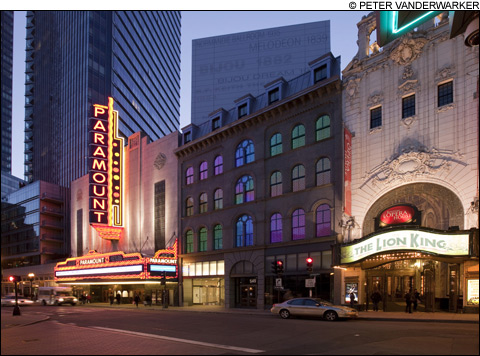Small is beautiful
If Orchard is the front man — the animating spirit behind the implementation and launch of ArtsEmerson — its guiding and nurturing presence is outgoing Emerson College President Jacqueline Liebergott (who announced last December that she would step down in 2011).
Almost 20 years ago, Liebergott was unexpectedly thrust into the president’s office. She picked up the pieces of the failed let’s-move-the-campus-to-Lawrence plan, took Emerson to its current location, slowly but surely recruited more competent and driven faculty members, nudged up entrance requirements, and tightened academic standards.
Liebergott was travelling the well-worn road of a local institution aiming for a national reputation. Boston College went down that path in the 1960s and ’70s, Boston University in the ’70s and ’80s, and Northeastern in the ’80s and ’90s.
With just under 4300 undergraduate and grad students, and 465 full- and part-time faculty, Emerson is a fraction of the size of Boston’s big three residential colleges.
As a school specializing in performance and communications, it occupies a niche in the same way that the Rhode Island School of Design — regarded as the nation’s best private art school — does.
Emerson, like RISD, may promote a small-is-beautiful ethic that stands in marked contrast to the vastness of the multiversity experience. And that ethic is perfectly valid. But in truth what Emerson offers that is unique is focus.
When I spoke with Liebergott about her tenure, she was relaxed, energetically serene. I sensed an iron hand in a velvet glove. ArtsEmerson was on its way, but her manner suggested that it was more than a work in progress. And while mindful of the hazards presented by a faltering and unsure economy, she seemed confident that the initiative would pay its intended conceptual dividends: to unite performers and students and academics with audiences in a new and flexible way for the mutual benefit of all concerned. Consider it a new form of Emersonianism — minus the Ralph.
When I asked her what the future might hold for Emerson, Liebergott was just as low key, but I detected a real sense of excitement.
“Emerson is building a campus in Los Angeles on Sunset Boulevard,” she said. “It is an opportunity to raise the profile of our already well-regarded students among the creative communities of the West Coast.”
And, I asked, beyond that?
“There is the Pacific Rim, the Northwest, China, and Japan. That,” she said, “is the future.”

COMING SOON: With the reclamation of the Paramount Center, Emerson College becomes the largest single custodian of theatrical seats in Boston. ArtsEmerson is about creatively leveraging those seats, engaging audiences so as to equate the Emerson brand with compelling international performance. |
Combat to culture
When I left her office and found myself again on Tremont Street, I realized that I was just a sashay away from the old, now essentially defunct X-rated Combat Zone.
A pincer movement by Tufts Medical Center and Emerson, with help from Suffolk University’s contingent expansion, had all but snuffed the life out of what was clinically referred to as Boston’s adult-entertainment district.
This was much to the pleasure of City Hall, neighboring Chinatown, and real-estate developers. Even before ground was broken for the Paramount reclamation and renovation, the Ritz Hotel and the AMC Loews Boston Common movie complex became a reality.